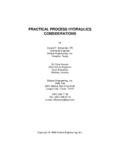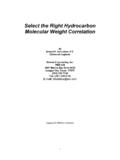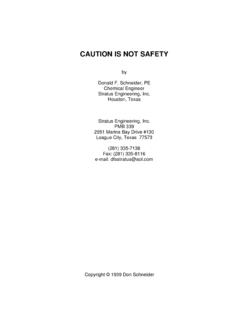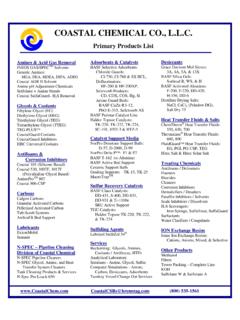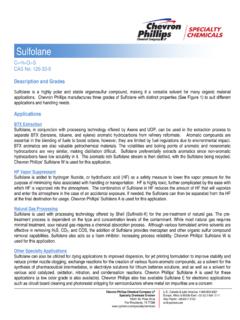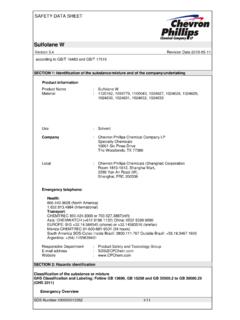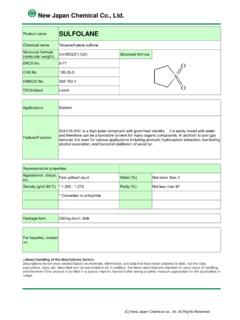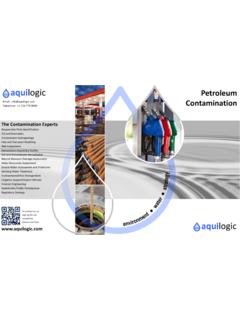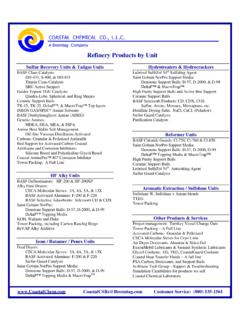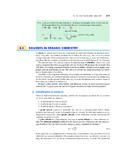Transcription of Extraction Unit Sulfolane Solvent Regeneration
1 Extraction unit Sulfolane Solvent Regeneration by Donald F. Schneider, PE Chemical Engineer Stratus Engineering, Inc. PMB 339 2951 Marina Bay Dr. #130 League City, Texas 77573 (281) 335-7138 Copyright 2003 Don Schneider i Extraction unit Sulfolane Solvent Regeneration by Donald F. Schneider, PE Stratus Engineering, Inc. Houston, Texas Abstract Aromatics Extraction units employ a Solvent to separate Aromatic compounds from other hydrocarbons. Sulfolane is one common compound used in the closed Solvent loop process. Over time the Solvent fouls, harming operation. Online Solvent Regeneration is performed to mitigate the deleterious effects of degradation. Solvent Regeneration is fraught with difficulties stemming from Sulfolane s physical properties and from the nature of cleansing nasty impurities from an uncooperative Solvent . Here we examine the operating and design issues associated with the three prevalent types of Solvent regenerators: Steam Assisted, Reboiled, and Flash.
2 Sulfolane -- Schneider 1 Introduction Liquid-Liquid Extraction units don t wear their Solvent out as it circles round the unit , but the Solvent does deteriorate and becomes fouled, harming operation and contributing to corrosion. Aromatics Extraction (Figure 1) units using Sulfolane as a Solvent suffer from Solvent contamination and address this problem by online Solvent Regeneration . Solvent Regeneration is fraught with difficulties stemming from Sulfolane s physical properties and from the nature of cleansing nasty impurities from an uncooperative Solvent . Here we examine the operating and design issues associated with the three prevalent types of Solvent regenerators. Solvent Degradation Reported Sulfolane (Figure 2) decomposition temperatures are 392 F [1] and 516 F [2]. The literature suggests 392 F is the onset of decomposition, while the high decomposition rate at 516 F is easily observed.
3 Oxygen s presence accelerates decomposition [1, 3, 4]. Unacceptably high corrosion at Paraffin Stripper and Aromatics Stripper reboiler temperatures of 350 F to 380 F can be experienced in units with oxygen intrusion. The reboilers and their associated equipment are corrosion focal points [3]. Solvent degradation products include SO2, acids and polymers [1, 5]. Acids are by their nature destructive. Many polymers are miscible in Sulfolane [6, 7]. Those that stay in solution reduce Solvent power, those that do not foul equipment. Sulfolane is also a good Solvent for capturing acid gases and Mercaptans. It is part of the Solvent system employed in an acid gas sweetening process. Any acid gas evolving from Sulfolane decomposition or associated corrosion could be held in solution throughout at least part of the Extraction unit interacting with degradation products and accelerating corrosion.
4 Sulfolane -- Schneider 2 Corrosion resulting from degradation contributes byproducts to the Solvent flow including; Iron solids, acid salts, and polymer solids. These accumulating wastes accelerate corrosion through erosion/corrosion, foul equipment, and lessen Solvent power. These materials cannot escape the Solvent loop as they are bottomed with Sulfolane from each column they enter. The Solvent decomposition mechanism is temperature related. Minimizing reboiler heat medium temperatures reduces decomposition and corrosion. Although bulk reboiler temperatures may be below the decomposition temperature, film temperatures are higher. Some units employ fired heater reboilers that accelerate decomposition with their high film temperatures. Regenerators should operate at as low a temperature as possible. This leads directly to low operating pressures to accommodate Sulfolane s low vapor pressure.
5 Electrolysis studies provide some decomposition mechanism information. Upon electro-oxidation [8], Sulfolane decomposition products include: CO2, SO2, Butene and Butane. Butene formation suggests a straightforward polymer production route. Butane formation reveals the importance of Hydrogen donors (acid, Water) in that Sulfolane possesses only 8 Hydrogen atoms while Butane has 10. Without Hydrogen donors, it is possible that Butene formation is favored leading to polymer generation. Regeneration Solvent Regeneration removes heavy material evolving from Solvent decomposition and the accompanying unit corrosion. Feed impurities such as chlorides can also be removed by Regeneration . Solvent contaminants lower Solvent power, foul equipment, and increase corrosion. Almost all Extraction unit Sulfolane Regeneration is accomplished by vacuum stripping or fractionating a lean Solvent slipstream taken from the Aromatics Stripper bottoms [1, 4, 5, 11, 12].
6 Regeneration is often semi-batch in that the regenerator is periodically shutdown for cleanout. Figure 3 depicts Sulfolane -- Schneider 3 Regeneration in block diagram format. Steam, if any is used, is not included in the figure. Regenerator charge rates are typically between three and 15 gpm. The overwhelming majority of material fed to the regenerator is sent overhead such that it is difficult to think of them as strippers though that is often what they are called. Clean Sulfolane is taken overhead and returned to the bottom of the Aromatics Stripper as a vapor, or returned to the lean Solvent feeding the extractor after being condensed. Particulates, polymers, tars, and acid salts are left behind after the Sulfolane is vaporized in the regenerator. The regenerator bottoms is heavy waste that is typically withdrawn intermittently since its flow rate is very low.
7 Some regenerator vessels are designed with a bottoms volume large enough to permit accumulation of this waste. Sulfolane vaporization is complicated by its physical properties. The low vapor pressure that makes Sulfolane a good Extraction Solvent raises Regeneration temperatures to near decomposition values, and certainly to a range at which corrosion is known to occur in other areas of the unit . Additionally, Sulfolane freezes at a high temperature, making the recovery of regenerated Solvent more difficult if it must be condensed (though the freeze point declines with increasing Water content). The solids-bearing regenerator residue freezes at a temperature higher than Sulfolane , complicating regenerator bottoms handling. Table 1 details Sulfolane s properties. Figure 4 depicts Sulfolane s vapor pressure by plotting Equation 1 [6] and individual data points [1, 2, 7].
8 Vapor Pressure (psia) = x 10^[ - (K) - x log10(T(K))] ( Eqn 1) Lean Solvent from the Aromatics Stripper bottoms contains a small amount of Water, typically to wt percent though it can be higher. This significantly boosts the vapor pressure above that of pure Sulfolane as shown in Figure 5. However, lean Solvent vapor pressure without Water present may actually be lower than that of pure Sulfolane -- Schneider 4 Sulfolane due to the presence of heavies. Once in the regenerator, the low lean Solvent Water content is quickly driven off. The vaporizing temperature of the Sulfolane and heavies left behind climbs. Three types of regenerators are commonly employed: Steam-assisted Reboiled Flash Steam-Assisted Regenerator To reduce the Regeneration temperature, or to operate at the same temperature but at higher pressure, Steam can be used to lower the Sulfolane partial pressure (Figure 6).
9 Lower regen temperatures diminish Solvent degradation and corrosion while higher pressures reduce operating costs and shrink equipment size. Steam-assist regenerator operating pressures are usually set so that the regenerator overhead vapor can pressure into the Aromatics Stripper thus eliminating the need for separate vacuum and condensing systems. Many Extraction unit discussions describe Steam-assisted regenerators [4, 5, 11, 12]. Steam-assisted Regenerators usually include a reboiler, typically stab-in, to maintain the column temperature that is cooled by vaporization. Stab-in reboilers are troublesome in this service. If they fail due to corrosion they are a lot of work to remove, and they interfere with interior column cleaning and work during turnarounds. Figure 7 provides estimated operating conditions for a Steam-assisted regenerator. These data assume the use of pure Steam.
10 This is often impractical. Adding fresh Steam increases variable costs. Adding fresh Steam also upsets the unit Water balance. Typically, regenerator Steam is supplied by vaporizing Water collected from unit accumulators and from the Raffinate Water Wash (Figure 1). Collected Water contains some level of Sulfolane . Steam Sulfolane contamination has a large effect on Regenerator operation as seen in Figure 8. Sulfolane -- Schneider 5 Steam-assisted Regenerator operation and design is also complicated by column internals hydraulics. The Figure 3 material balance illustrates the problem. The column bottoms flow is a very small fraction of the feed. Maintaining effective vapor/liquid contact throughout all trays is difficult with the wide liquid flow range. There is a large risk of blowing flood on the bottom trays. A bubble cap design is likely needed for the bottom trays and their low liquid flow.
